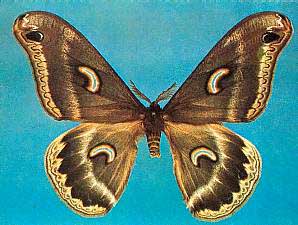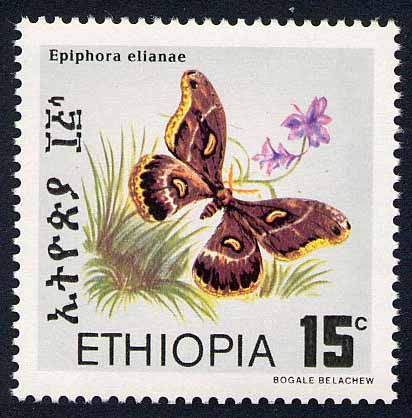Epiphora elianae
|
|
Updated as per Bouyer's Catalogue of African Saturniidae, 1999, January 4, 2006
Updated as per "Notes on the group of Epiphora antinorii (Oberthur, 1880) ....
Beitrage zur Kenntnis der wilden Seidenspinner Jarhgang 4, Heft 2, 16 Juli 2006, courtesy Stefan Naumann, April 4, 2007
Updated as per personal communication with Cyril Di Gennaro, November 30, 2008
Updated as per communication from Thierry Bouyer (elianae is a synonym of fournierae); February 2010
Updated as per personal communication with Dr. Andrea Sciarretta, Bale Mountains, Harenna Forest, Ethiopia, February 2010; November 6, 2010
|
Epiphora elianae
eh-PIF-er-uhmmee-lee-ANN-ay
Rougeot, 1974

Epiphora elianae male, Ethiopia, courtesy of Cyril Di Gennaro.
This site has been created by
Bill Oehlke at oehlkew@islandtelecom.com
Comments, suggestions and/or additional information are welcomed by Bill.
| TAXONOMY:
Superfamily: Bombycoidea, Latreille, 1802
Family: Saturniidae, Boisduval, [1837] 1834
Subfamily: Saturniinae, Boisduval, [1837] 1834
Tribe: Attacini, Blanchard, 1840
Genus: Epiphora, Wallengren, 1860
|
MIDI MUSIC
Wind Beneath My Wings
copyright C. Odenkirk
MIDI CITY
ON.OFF
<bgsound src="wings.mid" LOOP=FOREVER>
|
DISTRIBUTION:
Please note: DNA barcoding has shown that E. elianae is a synonym
of Epiphora fournierae.
Images from this page will subsequently be moved to the fournierae page.
Epiphora elianae
(wingspan: males: 108-112mm; females: ) is one of the few
Attacini in Africa. It flies in
southwestern Ethiopia:
Koffole, at elevations of 3000m.
Thierry Bouyer places Epiphora elianae
in the groupe antinorii with antinorii, magdalena
and marginimacula. These moths have relatively narrow and small
"c-shaped" crescents on all wings. They are without the white am bands
dividing the basal area from the median area. They fly in eastern
Africa.
|  |

Epiphora elianae, Postage Stamp: Ethiopia
FLIGHT TIMES AND PREFERRED FOOD PLANTS:
Epiphora
elianae larvae probably feed on Citrus, Maesopsis eminii, Paullinia,
Zanthoxylum macrophyllum and Fagara macrophylla.

Epiphora elianae = Epiphora fournierei, Bale Mountains, Harenna Forest, Ethiopia,
99mm, February 20, 2010, 2350m, courtesy of Andrea Sciarretta.
ECLOSION, SCENTING AND MATING:Epiphora elianae
females extend a scent gland from the
posterior tip of the abdomen to call in the night-flying males.The
pair remains
coupled until the following evening.The wings of the female are
more rounded than those of the male.
Epiphora elianae male (right), Addis Abebe, Ethiopia.
Rougeot indicates genitalia different from E. antinorii,
but no named E. antinorii specimens were used. |
 |
EGGS, LARVAE, COCOONS AND PUPAE:
The cocoon is double
walled and resembles the cocoon of the Hyalphora.
Larval Food Plants
It is hoped that this alphabetical listing followed by the common name of the foodplant will
prove useful. The list is not exhaustive. Experimenting with closely
related foodplants is worthwhile.
Citrus
Fagara macrophylla.....
Maesopsis eminii
Paullinia
Zanthoxylum macrophyllum.......
| Citrus
East African Satin Wood
Muhumula/Musira
Guarana
Hercules' club
|
Use your browser "Back" button to return to the previous page.
The pronunciation of scientific names is
troublesome for many. The "suggestion" at the top of the page is
merely a suggestion. It is based on commonly
accepted English pronunciation of Greek names and/or some
fairly well accepted "rules" for latinized scientific names.
The suggested pronunciations, on this page and on other pages,
are primarily put forward to assist those who hear with internal
ears as they read.
There are many collectors from different countries whose
intonations and accents would be different.
Some of the early describers/namers chose genus
and species names indicating some character of the insect, but more
often, they simply chose names from Greek or Roman mythology or
history.Those species names which end in "ensis" indicate a
specimen locale, and those which end in "i", pronounced "eye", honour
a contempory friend/collector/etc.
"Epiphora" is a medical condition of insufficient
drainage of the tear film from the eyes. The eyes are often watery,
lids inflamed and crusted. I do not know the the reason(s) for the
choice of Epiphora as the genus name, but perhaps the large hyaline
areas on the wings of mythimnia (specimen type) with the thick white
and yellow borders, were suggestive of watery, encrusted eyes.
The species name, "elianae" is probably honourific for a woman
named Eliana.




